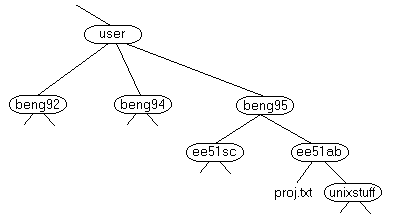
This session concerns UNIX and Unix-like operating systems, including Linux, MacOSX, Solaris and Irix. By operating system, we mean the suite of programs which make the computer work. The Gordon CS workstations and servers run Linux, while the computers in the KOSC lab run MacOSX.
On the workstations, X Windows provide a graphical interface between the user and UNIX. On Macintoshes, a graphical user interface effectively hides the underlying system from the user. However, knowledge of the command line is required for operations which aren't covered by a graphical program, or for when there is no windows system, for example, in a telnet session. Moreover, some tasks can be done much more easily using the command line, rather than by going through a GUI.
The UNIX operating system is made up of three parts; the kernel, the shell and the programs.
The kernel of UNIX is the hub of the operating system: it allocates time and memory to programs and handles the filestore and communications in response to system calls.
As an illustration of the way that the shell and the kernel work together, suppose a user types rm myfile (which has the effect of removing the file myfile). The shell searches the filestore for the file containing the program rm, and then requests the kernel, through system calls, to execute the program rm on myfile. When the process rm myfile has finished running, the shell then returns the UNIX prompt to the user, indicating that it is waiting for further commands.
The shell acts as an interface between the user and the kernel. When a user logs in, the login program checks the username and password, and then starts another program called the shell. The shell is a command line interpreter (CLI). It interprets the commands the user types in and arranges for them to be carried out. The commands are themselves programs: when they terminate, the shell gives the user another prompt (> on the workstations, % on the Macintoshes).
The adept user can customise his/her own shell, and users can use different shells on the same machine. Staff and students at Gordon have the bash shell on the workstations by default, and the tcsh shell on the Macintoshes.
The bash and tcsh shells have certain features to help the user inputting commands.
Filename Completion - By typing part of the name of a command, filename or directory and pressing the [Tab] key, the shell will complete the rest of the name automatically. If the shell finds more than one name beginning with those letters you have typed, it will beep, prompting you to type a few more letters before pressing the tab key again.
History - The shell keeps a list of the commands you have typed in. If you need to repeat a command, use the cursor keys to scroll up and down the list or type history for a list of previous commands.
Everything in UNIX is either a file or a process.
A process is an executing program identified by a unique PID (process identifier).
A file is a collection of data. They are created by users using text editors, running compilers etc.
Examples of files:
All the files are grouped together in the directory structure. The file-system is arranged in a hierarchical structure, like an inverted tree. The top of the hierarchy is traditionally called root.

In the diagram above, we see that the directory ee51ab contains the subdirectory unixstuff and a file proj.txt
To start a terminal session on one of the Linux workstations, click on the Terminal icon in the lower-left corner of the screen. A terminal window will appear with a Unix prompt (> or % as the case may be), waiting for you to start entering commands.
M.Stonebank@surrey.ac.uk, © 9th October 2000
Modified for use at Gordon College - russell.bjork@gordon.edu